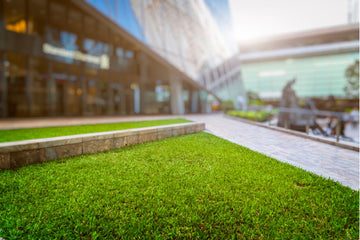If you’re feeling the heat, your lawn is too. High temperatures, dry spells, and water restrictions can push even the healthiest grass to its limits. But with the right care, you can help your lawn handle the heat and bounce back greener than ever.
Here’s how to protect and support your grass during the hottest weeks of the year.
1. Water Strategically
During a heatwave, water evaporates fast, so it’s not just how much you water, but when and how you do it.
Best Time To Water
Before 10 a.m. when it’s still cool.
This gives water time to soak in before the sun dries it out.
Prioritize Less Frequent, Deep Watering
Aim for 1 to 1.5 inches of water weekly, applied in longer sessions 2-3 times per week. This will encourage deeper root growth, making your lawn more drought-resilient.
Quick Test
Use a screwdriver or garden stake. If it goes in easily, your soil is wet enough. If you feel resistance, it’s time to water.
Bonus Tip
Apply a soil moisture manager like Hydretain after a watering or rainfall. It helps grass pull moisture from the air and retain hydration longer so you get more green out of every drop.
2. Mow Higher
Raise that mower blade! It is recommended to raise the height of the blades to 3-3.5” in this weather.
Cutting too short during extreme heat removes the protective canopy your grass needs.
- Never remove more than ⅓ of the blade at once
- Set blades high to encourage deep root systems and reduce water loss
- Mow during cooler hours to avoid stressing out the grass
- Leave clippings on the lawn to help insulate the soil and add natural nutrients
3. Limit Lawn Traffic
Dry, stressed grass is more likely to show footprints, tire marks, and pet paths… signs that can stick around!
- Avoid walking or mowing during peak heat
- Water any visible damage spots ASAP to prevent long-term injury
- If it sounds crunchy underfoot, it’s time to step back
4. Feed and Fortify (When Conditions Allow)
Fertilizing in hot weather is all about balance. You want to support root strength and colour, but not encourage fast growth that can add extra stress. Choose a summer-safe fertilizer to strengthen cell walls, improve heat tolerance, and enhance colour and root health.
Important: During hot, dry weather, when temperatures are extreme and there’s no rain in the forecast, do not fertilize. Even light rainfall in hot, humid weather won’t help much as nitrogen can quickly become unstable and be lost to the air, wasting product and money.
Instead, wait for ideal conditions: cooler temperatures with sufficient rain in the forecast.
If your lawn is already stressed or yellowing, hold off until you see signs of recovery. When you do fertilize, apply in the early morning (before 10 a.m.) or early evening (after 6 p.m.) to reduce stress and improve absorption.
5. Dormancy Is Normal
Cool-season grasses like Kentucky Bluegrass may go brown during long heat spells. This is a perfectly normal and natural defence.
With consistent watering, even if less frequent, your lawn can survive dormancy and recover when the heat breaks. Don’t overcorrect or over-fertilize, just give it time and water wisely.
Know Your Grass
Some grass types handle heat better than others. If your grass thins out every August, it might be time to reseed or overseed with more heat-tolerant varieties.
Conclusion
A thriving lawn in hot weather doesn’t happen by accident. It comes down to smart, steady care. Prioritize deep watering, higher mowing, thoughtful feeding, and gentle foot traffic. Heat stress happens, but with the right approach, your lawn can power through and stay healthier, longer.
We’re here to help you beat the heat and stay green all season long.





